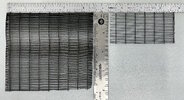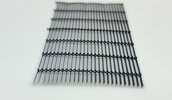How reliable is the intel that the 17 was squeezed down for the 23?
Has anyone compared the raw materials between the two to confirm the spacing is the only difference.
Side by side does one look like a squeezed version of the other?
Sure seems feasible to create a precision "scrunching" machine over sourcing material to weave 23 from scratch. Not trivial but logistically way ahead. Some sort of top/bottom supported walking beam. Hold the first louver stable with a split (top/bottom) clamp. Walk the second louver closer by just a little with the same clamp system but on a stage of some sort. Index and repeat one row at a time. As already stated, it only has to be as wide as the hobby requires but of course work with the 17 material that is already produced.
Hmmm.
So, anyone know if the 17 material is the same as 23 other than the pitch? My mind is already thinking up ideas how to do this.
Has anyone compared the raw materials between the two to confirm the spacing is the only difference.
Side by side does one look like a squeezed version of the other?
Sure seems feasible to create a precision "scrunching" machine over sourcing material to weave 23 from scratch. Not trivial but logistically way ahead. Some sort of top/bottom supported walking beam. Hold the first louver stable with a split (top/bottom) clamp. Walk the second louver closer by just a little with the same clamp system but on a stage of some sort. Index and repeat one row at a time. As already stated, it only has to be as wide as the hobby requires but of course work with the 17 material that is already produced.
Hmmm.
So, anyone know if the 17 material is the same as 23 other than the pitch? My mind is already thinking up ideas how to do this.



